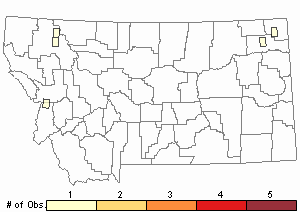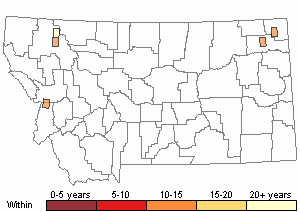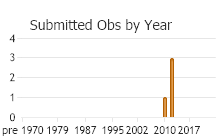View in other NatureServe Network Field Guides
NatureServe
Montana
Utah
Wyoming
Idaho
Wisconsin
British Columbia
South Carolina
Yukon
California
New York
Lake Fingernailclam - Musculium lacustre
Other Names:
Musculium ryckholti
General Description
Fingernail clams are small "mostly about the size of a finger or thumbnail" bottom-dwelling, filter-feeders found in ponds, lakes and streams throughout Montana. They are native and can be quite abundant, providing food for a variety of animals and producing large accumulations of empty shells. These shells can be quite fragile compared to introduced Asian clams of the family Corbiculidae, which have only been reported in Lake Elmo near Billings, Montana.
Diagnostic Characteristics
"Shell large, more than 8 mm long; beaks prominent, distinctly raised above the dorsal margin; shell high in outline, height 7/8 or more of length; dorsal margin rounded; posterior end at a greater angle to the dorsal margin and striae coarser than in S. PARTUMEIUM. Smaller shells, less than 8 mm long, may be distinguished by the fact that the striae fade out in the region of the beaks; the posterior end and dorsal margin are rounded or form an obtuse angle; and the posterior end of the shell is truncate, the beaks swollen." (La Rocque 1967:295). La Rocque (1967:295) cites dimensions from various authors and collection sites in the following ranges: L. 14-5.4, H. 11.5-4.5, D. 8.2-3.0 mm.
Range Comments
La Rocque (1967:297) includes Montana in range, indicates the species occurs throughout the Mississippi and Missouri River drainages; Burch (1972:6) indicates the species occurs "from the treeline in Canada and Alaska south, throughout Canada and the United States" except in the southwestern states.
Observations in Montana Natural Heritage Program Database
Number of Observations: 5
(Click on the following maps and charts to see full sized version)
Map Help and Descriptions
Relative Density

Recency



 (Observations spanning multiple months or years are excluded from time charts)
(Observations spanning multiple months or years are excluded from time charts)
Habitat
The species is most abundant in small lakes and ponds, but is also found in larger lakes, rivers, and creeks. It seems to prefer muddy bottoms. Has been collected from ponds, lakes, and bays. It has also been recorded from ditches, marshes, puddles, muddy brooks, and larger lakes in Europe at an altitude of 1,300 to 1,400 m. In North America "it occurs in swamps, ponds, lakes, or streams on a firm bottom of fine deep or hard packed mud, fine gravel, and hard clay, in water up to 0.6 m deep; it has been collected in water with pH 6.4-7.64, fixed carbon dioxide ratio 9.3-18.87 ppm." (La Rocque 1967:295-296). Clarke (1981:378) indicates the species in found in perennial-water lakes and ponds, and also in rivers and streams of all sizes, and occasionally in roadside ditches.
Food Habits
Fingernail clams are mostly filter-feeders, siphoning in floating particulate organic materials ( small plant or animal) from the water column and straining out the particles and expel the strained water. Pedal feeding from the bottom with the foot muscle has also been observed.
Reproductive Characteristics
"A few up to many (1-28) young have been found in Canadian specimens; the young within a single parent are all the same size or of only two different sizes." (Clarke 1981:378).
Stewardship Responsibility
References
- Literature Cited AboveLegend:
 View Online Publication
View Online Publication Burch, J.B. 1972. Freshwater Sphaeriacean clams (Mollusca:Pelecypoda) of North America. EPA Biota of Freshwater Ecosystems Identification Manual No. 3. 31 pp.
Burch, J.B. 1972. Freshwater Sphaeriacean clams (Mollusca:Pelecypoda) of North America. EPA Biota of Freshwater Ecosystems Identification Manual No. 3. 31 pp. Clarke, A.H. 1981. The freshwater molluscs of Canada. National Museum of Natural Sciences, National Museums of Canada, Ottawa. 446 pp.
Clarke, A.H. 1981. The freshwater molluscs of Canada. National Museum of Natural Sciences, National Museums of Canada, Ottawa. 446 pp. La Rocque, A. 1967. Pleistocene Mollusca of Ohio. Department of Natural Resources, Division of Geological Survey Bulletin 62, Part 2. 113-365 + 8 plates.
La Rocque, A. 1967. Pleistocene Mollusca of Ohio. Department of Natural Resources, Division of Geological Survey Bulletin 62, Part 2. 113-365 + 8 plates.
- Additional ReferencesLegend:
 View Online Publication
View Online Publication
Do you know of a citation we're missing? Hendricks, P., S. Lenard, D.M. Stagliano, and B.A. Maxell. 2013. Baseline nongame wildlife surveys on the Fort Peck Indian Reservation. Report to the Assiniboine and Sioux Tribes of the Fort Peck Indian Reservation. Montana Natural Heritage Program, Helena, MT. 83 p.
Hendricks, P., S. Lenard, D.M. Stagliano, and B.A. Maxell. 2013. Baseline nongame wildlife surveys on the Fort Peck Indian Reservation. Report to the Assiniboine and Sioux Tribes of the Fort Peck Indian Reservation. Montana Natural Heritage Program, Helena, MT. 83 p.
- Web Search Engines for Articles on "Lake Fingernailclam"
- Additional Sources of Information Related to "Mussels / Clams"





